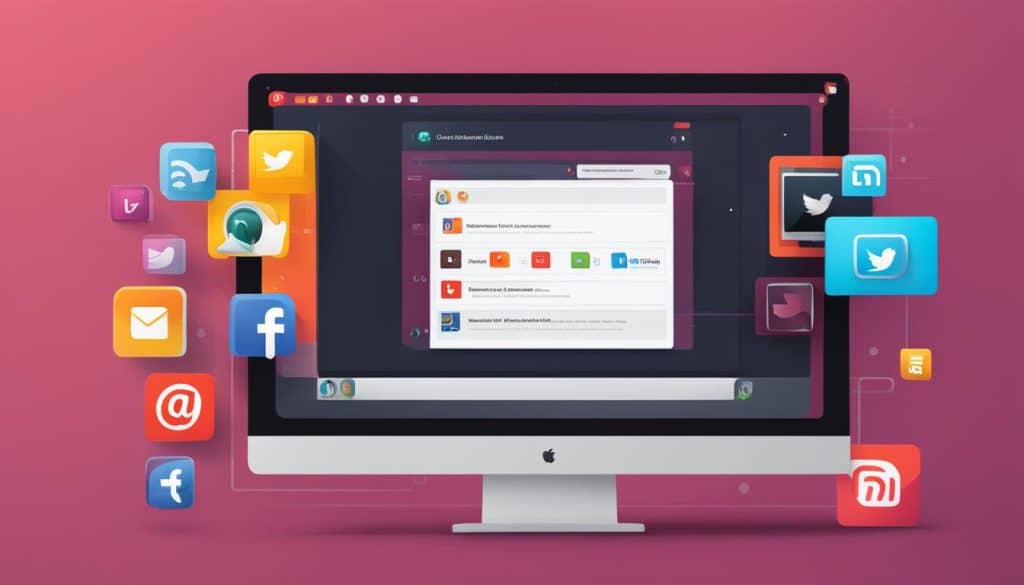Social media integration is an essential component of a successful marketing strategy in today’s digital landscape. By seamlessly incorporating social media channels into various aspects of your marketing efforts, you can unlock numerous benefits and maximize your brand’s online presence. In this article, we will explore the importance of social media integration, discuss effective strategies, highlight useful tools, and provide valuable insights into the benefits it can bring to your business.
When it comes to social media integration, utilizing the right tools is crucial. These tools can streamline your processes, automate tasks, and provide valuable analytics to measure the impact of your social media efforts. From social media management platforms like Hootsuite and Buffer to plugins and widgets that enable social login and sharing, there is a wide range of options available to help you integrate social media seamlessly into your marketing strategy.
Key Takeaways:
- Social media integration is vital for enhancing brand visibility and increasing customer engagement.
- Integrating social media into your marketing strategy can provide targeted advertising options and valuable analytics.
- By integrating social media into your website and email marketing, you can amplify your content distribution and reach a wider audience.
- Successful examples of social media integration include social login options, QR code campaigns, and hashtag campaigns.
- Tools such as social media management platforms and plugins can assist in seamless social media integration.
The Importance of Social Media Integration
Social media integration for business plays a critical role in today’s digital landscape. By incorporating social media into your marketing strategy, you can unlock a host of benefits that can significantly propel your brand’s success.
Enhanced Brand Visibility
One of the key advantages of social media integration is its ability to boost brand visibility. With platforms like Facebook, Instagram, Twitter, and LinkedIn, you can reach a vast audience and increase your brand’s online presence. By regularly engaging with your followers and posting valuable content, you can amplify your visibility and extend your brand’s reach.

Increased Customer Engagement
Social media integration allows you to connect directly with your audience and foster meaningful engagement. By leveraging social media platforms, you can interact with your customers, respond to their inquiries, and provide personalized support. This direct connection humanizes your brand and builds trust, resulting in higher customer satisfaction and loyalty.
Targeted Advertising Options
Integrating social media into your marketing strategy provides access to powerful advertising features. Platforms like Facebook and LinkedIn offer advanced targeting options that allow you to reach specific demographics, interests, and behaviors. This precision targeting ensures that your advertisements are seen by the right audience, maximizing your marketing budget and driving better results.
Valuable Analytics
Social media platforms offer robust analytics tools that provide valuable insights into your audience’s behavior and preferences. By analyzing metrics such as engagement rates, click-through rates, and demographic data, you can refine your marketing strategies and make data-driven decisions. These insights enable you to tailor your content to resonate with your audience, resulting in higher engagement and conversion rates.
Amplified Content Distribution
With social media integration, you can leverage your social media profiles to amplify the reach of your content. By sharing blog posts, videos, and other valuable content on social media, you can increase its visibility and attract more visitors to your website. This expanded distribution allows you to reach new audiences and generate organic traffic, ultimately boosting your brand’s online presence.
Exploration of Cross-Platform Solutions
Integrating social media into your marketing strategy opens up opportunities for cross-platform solutions. By linking your website, email campaigns, and other digital channels to your social media profiles, you create a unified customer experience. This cohesive approach ensures that your branding remains consistent across platforms and provides seamless interactions for your audience.
By understanding the importance of social media integration for business, you can harness its potential to drive brand growth, foster customer relationships, and outperform competitors in today’s digital era.
Benefits of Social Media Integration
Social media integration offers numerous benefits to businesses looking to enhance their online presence and engage with their target audience effectively. By integrating social media platforms into your marketing strategy, you can unlock a range of advantages for your brand. Here are the key benefits of social media integration:
- Increased brand visibility: By integrating social media platforms into your marketing efforts, you can significantly increase your brand’s visibility. By leveraging the massive user bases and active communities on social media, you can reach a wider audience and attract more attention to your brand.
- Enhanced customer engagement: Social media integration allows you to connect directly with your audience and promote meaningful interactions. By leveraging social media as a two-way communication channel, you can engage with your customers, address their queries, and build meaningful relationships that foster brand loyalty.
- Targeted ad options: Integrating social media into your marketing strategy gives you access to powerful targeted advertising options. Platforms like Facebook, Instagram, and LinkedIn offer sophisticated targeting features that help you reach the right audience based on demographics, interests, and behaviors. This precision targeting can significantly improve the effectiveness of your ad campaigns.
- Access to valuable analytics: Social media platforms provide robust analytics tools that offer valuable insights into your audience’s behavior, preferences, and engagement patterns. By integrating these analytics tools into your marketing strategy, you can gather data-driven insights that inform your decision-making process and help you optimize your campaigns for better results.
- Amplified content distribution: Social media integration allows you to distribute your content more effectively and reach a larger audience. By seamlessly sharing your website content, blog posts, videos, and other marketing materials across social media platforms, you can amplify your content’s reach and generate more visibility for your brand.
- Exploration of cross-platform solutions: Integrating social media platforms enables you to explore cross-platform solutions and leverage the strengths of different platforms for your marketing efforts. By integrating various social media platforms, you can create a cohesive and interconnected online presence that maximizes your brand’s reach and impact.
By leveraging these benefits of social media integration, you can create an effective and comprehensive marketing strategy that enables you to connect with your target audience, boost brand visibility, and achieve your marketing objectives.

Example Social Media Integration Strategies
When it comes to implementing social media integration, there are several strategies you can consider. Here are some examples:
| Strategy | Description |
|---|---|
| Social media login | Allow users to log in to your website or app using their social media accounts. This simplifies the registration process and enhances user experience. |
| Social media sharing buttons | Add social media sharing buttons to your website, allowing users to easily share your content on their social media profiles. |
| Social media-based commenting | Enable social media-based commenting on your blog or website, allowing users to comment using their social media accounts. This increases engagement and can improve SEO. |
| Social media feeds | Embed social media feeds on your website to display real-time updates and social proof. This can boost credibility and keep your website content fresh. |
These are just a few examples of social media integration strategies. The specific strategies you choose should align with your business goals, target audience, and overall marketing objectives.
Social Media Integration for Your Website
Integrating social media into your website can significantly boost your online presence and traffic. By incorporating various social media elements, you can create a seamless experience for your visitors and enhance your brand’s visibility across platforms. Let’s explore some key strategies for social media integration on your website.
1. Social Media Buttons for Easy Sharing
Adding social media buttons to your website enables visitors to easily share your content on their preferred social platforms. By including prominent buttons for popular social media channels such as Facebook, Twitter, Instagram, and LinkedIn, you encourage users to share your content with their network. This can lead to increased exposure and traffic to your website.
2. Implement Social Login Options
Implementing social login options on your website allows users to log in or sign up using their existing social media accounts. This eliminates the need for users to create a separate login account, providing a seamless and convenient user experience. Additionally, social login offers benefits such as personalized user data and the ability to personalize content based on user preferences.
3. Display Social Proof
Social proof is a powerful tool in building trust and credibility. Displaying social proof on your website, such as user-generated content, testimonials, or social media mentions, can influence potential customers and increase their confidence in your brand. Incorporating social proof elements strategically throughout your website can help to boost conversions and drive customer engagement.
4. Enable Social Media-Based Commenting
Allowing users to comment using their social media accounts can increase engagement on your website. Social media-based commenting encourages users to share their thoughts, opinions, and feedback, fostering a sense of community and discussion. Additionally, these comments can also contribute to your website’s search engine optimization (SEO) efforts by generating user-generated content.
5. Integrate Social Media Sharing and Saving Options
Integrating social media sharing and saving options on product pages and thank you pages can amplify your content’s reach. By providing easy-to-use sharing buttons and options for users to save products or content for later, you empower them to spread the word about your brand and stay connected. This can lead to increased brand awareness and repeat visits to your website.
| Benefits of Social Media Integration for Your Website | Social Media Elements |
|---|---|
| Increased online presence and traffic | Social media buttons for easy sharing |
| Enhanced user experience | Social login options |
| Building trust and credibility | Social proof display |
| Increased engagement and user-generated content | Social media-based commenting |
| Amplified content reach and brand awareness | Social media sharing and saving options |
Social Media Integration for Email Marketing
Incorporating social media into your email marketing campaigns can greatly enhance their effectiveness and reach. By seamlessly integrating your social media profiles into your email strategy, you can promote your brand, increase engagement, and grow your subscriber base.
One effective way to promote your social profiles is by including social media icons or links in the footer section of your emails. This allows your subscribers to easily connect with you on various social platforms, expanding your online presence. Placing social media icons prominently in your email template can also serve as a visual reminder for your recipients to engage with your brand on social media.
Another valuable technique is to include a newsletter signup tab within your emails. This encourages recipients to subscribe to your newsletter directly from their inbox, helping you grow your mailing list and reach a wider audience. By integrating this signup feature into your emails, you can capture leads and nurture them through personalized email campaigns.
To further enhance the integration, consider incorporating social media content and calls-to-action (CTAs) in your email templates. For example, you can embed social media posts or videos relevant to your campaign or include CTAs directing recipients to follow your social profiles or participate in discussions using specific hashtags. This not only encourages engagement but also allows you to leverage the power of social media in driving traffic and conversions.
When leveraging social media integration for email marketing, it’s important to ensure that your emails are visually appealing, mobile-friendly, and optimized for various email clients. This will maximize the chances of your recipients engaging with both your email content and your social media channels.
Remember, social media integration for email marketing offers a valuable opportunity to engage with your audience across multiple platforms and drive business growth. By strategically promoting your social profiles, optimizing your email content, and incorporating social media content and CTAs, you can harness the power of social media to strengthen your email marketing efforts.
Key Takeaways
- Promote your social profiles through social media icons or links in the footer section of your emails.
- Include a newsletter signup tab to capture leads and expand your mailing list.
- Integrate social media content and CTAs in your email templates to drive engagement and traffic.
- Ensure your emails are visually appealing, mobile-friendly, and optimized for different email clients.
Successful Examples of Social Media Integration
When it comes to successful social media integration, there are several companies that have excelled in incorporating social media into their marketing strategies. These examples demonstrate the diverse ways in which social media can be integrated to engage and connect with the audience. Let’s take a look at some prominent examples:
Sprinklr’s Social Login Options
Sprinklr, a leading social media management platform, has successfully implemented social login options to provide a simplified user experience. By allowing users to log in using their social media credentials, Sprinklr has eliminated the need for users to create new accounts, making it easier for them to engage with the platform. This seamless integration not only enhances user experience but also facilitates data collection, allowing Sprinklr to gain valuable insights into their audience.
Coca-Cola’s Social Media QR Codes
One of the most recognizable brands worldwide, Coca-Cola has integrated social media QR codes on its products. These QR codes serve as a quick and convenient way for consumers to interact with the brand on social media platforms. By scanning the QR codes, customers can instantly access exclusive content, promotions, and engage with the brand on a deeper level. This integration effectively bridges the gap between offline and online marketing, providing a seamless customer experience.
Lay’s #DoUsAFlavor Hashtag Campaign
Famous for its unique and bold flavors, Lay’s successfully launched the hashtag campaign #DoUsAFlavor. The campaign encouraged customers to suggest new and exciting flavors, leveraging the power of user-generated content and social media. By using the hashtag, Lay’s engaged its audience and built a sense of community around their brand. This integration showcased how social media can be utilized to spark creativity, foster engagement, and generate buzz.
Examples of Social Media Integration
To summarize, Sprinklr’s social login options, Coca-Cola’s QR codes, and Lay’s hashtag campaign exemplify successful social media integration. These examples demonstrate the creative and effective ways in which social media can be seamlessly integrated into marketing strategies. By leveraging social login options, QR codes, and hashtag campaigns, these companies have enhanced user experience, increased engagement, and created a strong connection with their audience.
| Company | Integration Method |
|---|---|
| Sprinklr | Social login options |
| Coca-Cola | Social media QR codes |
| Lay’s | #DoUsAFlavor hashtag campaign |

Tools for Social Media Integration
When it comes to social media integration, there is a wide range of tools available to help streamline your efforts. These tools encompass social media management platforms, plugins, and widgets that enable seamless integration across various platforms. By leveraging these tools, you can effectively manage your social media presence and improve your overall marketing strategy.
Social Media Management Platforms
Social media management platforms are powerful tools that allow you to manage multiple social media accounts from a single dashboard. They provide comprehensive features such as scheduling posts, monitoring engagement, analyzing performance, and collaborating with team members.
Examples of popular social media management platforms include:
| Platform | Description |
|---|---|
| Hootsuite | A robust platform that offers scheduling, analytics, and team collaboration features, covering major social media channels. |
| Sprout Social | Provides advanced analytics, engagement tools, and social listening capabilities to optimize your social media strategy. |
| Buffer | Offers easy scheduling, analytics, and audience insights to enhance your social media presence. |
Plugins and Widgets
In addition to management platforms, plugins and widgets can be valuable tools for social media integration. These can be easily implemented on your website or content management system to enhance user experience and facilitate social media engagement.
Examples of commonly used plugins and widgets for social media integration include:
- Social login plugins – Allow users to log in to your website using their social media profiles, simplifying the registration process.
- Social sharing plugins – Enable visitors to share your content on various social media platforms with a single click.
- Social media integration widgets – Display your social media feeds or icons on your website, encouraging visitors to follow and engage with your brand.
By leveraging these plugins and widgets, you can seamlessly integrate social media functionality into your website, driving user engagement and expanding your online presence.
Remember, choosing the right tools for social media integration depends on your specific needs and goals. It’s essential to consider factors such as budget, desired features, and compatibility with your existing systems.
Mistakes to Avoid in Social Media Integration
While integrating social media into your marketing strategy can be beneficial, it’s important to be aware of common mistakes that can hinder your success. By understanding these mistakes and implementing best practices, you can ensure a seamless social media integration that enhances your brand and engages your audience effectively.
1. Not Optimizing Social Media Profiles
One of the biggest mistakes you can make is neglecting to optimize your social media profiles. Your profiles serve as a representation of your brand on social platforms, so it’s crucial to make a positive impression. Optimize your profiles by using high-quality profile pictures and cover photos, writing compelling and keyword-rich descriptions, and including a link to your website. This will help you attract the right audience and establish a cohesive online presence.
2. Failing to Provide Valuable and Engaging Content
The key to successful social media integration is providing valuable and engaging content to your audience. Avoid the mistake of constantly self-promoting and instead focus on creating content that educates, entertains, and adds value. Utilize a mix of content types such as informative blog posts, eye-catching images, entertaining videos, and engaging polls or quizzes. By delivering valuable content consistently, you can build trust, foster relationships, and keep your audience coming back for more.
3. Neglecting to Monitor and Respond to Social Media Interactions
Ignoring social media interactions is a common mistake that can severely impact your brand’s reputation. Make sure to regularly monitor your social media accounts for comments, messages, and mentions. Engage with your audience by responding promptly and courteously, addressing customer inquiries or concerns, and acknowledging positive feedback. By actively participating in conversations and providing excellent customer service, you can cultivate a loyal following and enhance your brand’s credibility.
4. Not Analyzing and Utilizing Social Media Analytics
Social media analytics provide valuable insights into your audience’s behavior, preferences, and engagement patterns. Failing to analyze and utilize these analytics is a missed opportunity for improvement. Take advantage of the available data to understand which content resonates the most with your audience, identify peak engagement times, and track the success of your campaigns. Use these insights to optimize your social media strategy, refine your messaging, and drive better results.
Social Analytics Integration for Marketing Campaigns
Integrating social media analytics tools such as Facebook Pixel and LinkedIn Insights Tag into your marketing campaigns can provide valuable data to improve your strategies. By leveraging social analytics integration, you gain insights into various aspects of your audience, website visitors, and post performance, allowing you to make data-driven decisions for a more successful marketing approach.
Understanding Audience Demographics
Facebook Pixel and LinkedIn Insights Tag enable you to track and analyze the demographic data of your social media audience. This information includes age, gender, location, and interests. By understanding the characteristics of your target audience, you can tailor your content and marketing messages to resonate with their preferences, leading to higher engagement and conversion rates.
Tracking Website Visitors
With social analytics integration, you can track how social media platforms drive traffic to your website. Facebook Pixel and LinkedIn Insights Tag allow you to monitor the number of website visits, track the actions users take on your website, and attribute conversions to specific social media campaigns. This data empowers you to optimize your website’s performance and user experience, ultimately increasing your chances of converting visitors into customers.
Evaluating Post Performance
Measuring the performance of your social media posts is crucial for refining your content strategy. Through social analytics integration, you can assess the reach, engagement, and conversions generated by individual posts. This data helps you identify the types of content that resonate most with your audience and replicate their success in future campaigns.
“Social analytics integration provides invaluable insights into audience demographics, website visitors, and post performance, empowering marketers to make data-driven decisions and optimize their marketing campaigns.”
By harnessing the power of social analytics integration, you can segment your audience, retarget specific groups, and optimize your marketing efforts for better lead generation and sales. Aligning your strategies with actionable data ensures that you stay ahead of the competition and deliver more effective and targeted marketing campaigns.
| Benefits of Social Analytics Integration | Facebook Pixel | LinkedIn Insights Tag |
|---|---|---|
| Detailed audience demographics | ✓ | ✓ |
| Website visitor tracking | ✓ | ✓ |
| Post performance evaluation | ✓ | ✓ |
| Data-driven decision making | ✓ | ✓ |
Conclusion
Social media integration is an essential component of a successful marketing strategy. By seamlessly incorporating social media into your website, email marketing, and overall campaigns, you can enhance your brand’s visibility and increase customer engagement. Furthermore, by utilizing the right social media integration strategies and tools, you can gather valuable insights into consumer behavior and optimize your marketing efforts.
By integrating social media into your website, you can provide a seamless user experience with features such as social login and social media-based commenting. This not only simplifies the user journey but also encourages greater interaction and promotes social sharing, expanding your reach across various platforms.
Incorporating social media into your email marketing allows you to further amplify your message and increase its impact. By promoting your social profiles and incorporating social media content in your emails, you can encourage your audience to connect with you on multiple channels. This not only strengthens your brand presence but also provides additional touchpoints for customer engagement.
Ultimately, social media integration is about creating a cohesive and interconnected online presence. By effectively integrating social media into your marketing strategy, you can build a strong brand, boost customer engagement, and drive business growth. So, embrace social media integration strategies, leverage the power of seamless integration, and unlock the full potential of your marketing efforts.

FAQ
What is social media integration?
Social media integration is the practice of incorporating social media channels into every part of your marketing strategy, connecting them with your website, email campaigns, CRM software, e-commerce software, and customer service software.
Why is social media integration important for businesses?
Social media integration is important for businesses because it enhances brand visibility, increases customer engagement, provides targeted advertising options, offers valuable analytics, amplifies content distribution, and explores cross-platform solutions.
What are the benefits of social media integration?
The benefits of social media integration include increased brand visibility, enhanced customer engagement, targeted ad options, access to valuable analytics, amplified content distribution, and the ability to explore cross-platform solutions.
How do I integrate social media into my website?
You can integrate social media into your website by adding social media buttons, implementing social login options, displaying social proof, enabling social media-based commenting, and integrating social media sharing and saving options on product pages and thank you pages.
How can I integrate social media into my email marketing?
You can integrate social media into your email marketing by promoting your social profiles through social media icons or links in your emails, including a newsletter signup tab, and integrating social media content and CTAs in your email templates.
Can you provide examples of successful social media integration?
Examples of successful social media integration include Sprinklr’s use of social login options, Coca-Cola’s incorporation of social media QR codes on its products, and Lay’s hashtag campaign #DoUsAFlavor.
What tools can help with social media integration?
Popular tools for social media integration include Hootsuite, Sprout Social, Buffer, and various social login plugins and social sharing plugins.
What are some mistakes to avoid in social media integration?
Some mistakes to avoid in social media integration include not optimizing social media profiles, failing to provide valuable and engaging content, neglecting to monitor and respond to social media interactions, and not analyzing and utilizing social media analytics.
How can social analytics integration improve marketing campaigns?
Social analytics integration tools like Facebook Pixel and LinkedIn Insights Tag provide valuable data on audience demographics, website visitors, and post performance, enabling you to segment your audience, retarget specific groups, and optimize your marketing efforts.
Why is seamless social media integration important?
Seamless social media integration is important because it ensures a successful and comprehensive marketing strategy, enhancing brand visibility, increasing customer engagement, and providing valuable insights into consumer behavior.





